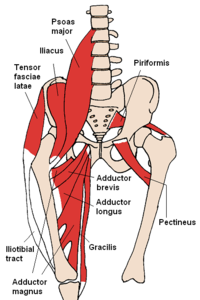
Photo from wikipedia
Simple Summary Femoroacetabular impingement represents an important burden for affected patients in their daily life. Possible and successful treatments to alleviate patient symptoms are corrections of bone deformities using either… Click to show full abstract
Simple Summary Femoroacetabular impingement represents an important burden for affected patients in their daily life. Possible and successful treatments to alleviate patient symptoms are corrections of bone deformities using either arthroscopy or surgical hip dislocation. Nevertheless, the aforementioned surgeries might also weaken the operated hip in addition to the impact of the pathology itself. There is, however, little or no published data on the impact of arthroscopy and surgical hip dislocation on hip muscles strength, which motivated us to perform this study. For arthroscopy, we found that patients exhibited on the operated hip a moderate decrease in abductors strength, as well as a small but noticeable decrease in hamstrings, external rotators and flexors strengths three months after surgery. Interestingly, patients also had a small but relevant strength decrease on the non-operated side, located on external rotators. For surgical hip dislocation, patients exhibited on the operated hip a large decrease in internal rotators strength and a moderate decrease in abductors, quadriceps and external rotators strengths. These findings suggest that several hip muscles can be moderately or largely affected after arthroscopy (abductors) or surgical hip dislocation (internal and external rotators, abductors and quadriceps). This study also suggests that a rehabilitation method based on isolated muscle reinforcement and functional exercises is needed and emphasizes the need for a rehabilitation protocol that goes beyond three postoperative months. Abstract Hip arthroscopy and surgical hip dislocation (SHD) can be adequate surgical options for patients suffering from femoroacetabular impingement (FAI) syndrome, but there is to date no published data on their impact on hip muscles strength. The purpose of this retrospective study was, therefore, to evaluate it on a consecutive series of 50 FAI patients treated either by arthroscopy (n = 29, aged 27.4 ± 7.5 years, 76% of women) or SHD (n = 21, aged 25.9 ± 6.5 years, 38% of women) at La Tour Hospital between 2020 and 2021. The bilateral isometric strengths of eight hip-related muscles were evaluated before and three months after surgery (halfway through the rehabilitation program). For arthroscopy, a statistically significant (p < 0.05) reduction in hip muscles strength could be noted on the operated hamstrings (1.49 ± 0.43 vs. 1.39 ± 0.38 Nm/kg), flexors (1.88 ± 0.46 vs. 1.73 ± 0.41 Nm/kg), abductors (1.97 ± 0.42 vs. 1.72 ± 0.40 Nm/kg) and external rotators (1.17 ± 0.40 vs. 1.04 ± 0.37 Nm/kg). The abductors were the most affected muscles, with 45% of the patients suffering from a strength reduction ≥15%. The non-operated external rotators were also affected but to a lesser extent (1.21 ± 0.38 vs. 1.10 ± 0.36 Nm/kg). For SHD, a statistically significant strength reduction could be noted on the operated extensors (2.28 ± 0.84 vs. 2.05 ± 0.70 Nm/kg), abductors (1.87 ± 0.49 vs. 1.65 ± 0.41 Nm/kg), quadriceps (2.96 ± 0.92 vs. 2.44 ± 0.89 Nm/kg), external rotators (1.16 ± 0.42 vs. 0.93 ± 0.36 Nm/kg) and internal rotators (1.26 ± 0.38 vs. 0.96 ± 0.30 Nm/kg). The internal rotators were the most affected muscles, with 75% of the patients suffering from a strength reduction ≥15%. To conclude, particular attention should be paid to operated abductors for patients treated by arthroscopy as well as operated internal/external rotators, abductors and quadriceps for those treated by surgical hip dislocation. It reinforces that a rehabilitation method based on isolated muscle reinforcement and functional exercises that goes beyond three postoperative months is needed.
Journal Title: Biology
Year Published: 2022
Link to full text (if available)
Share on Social Media: Sign Up to like & get
recommendations!